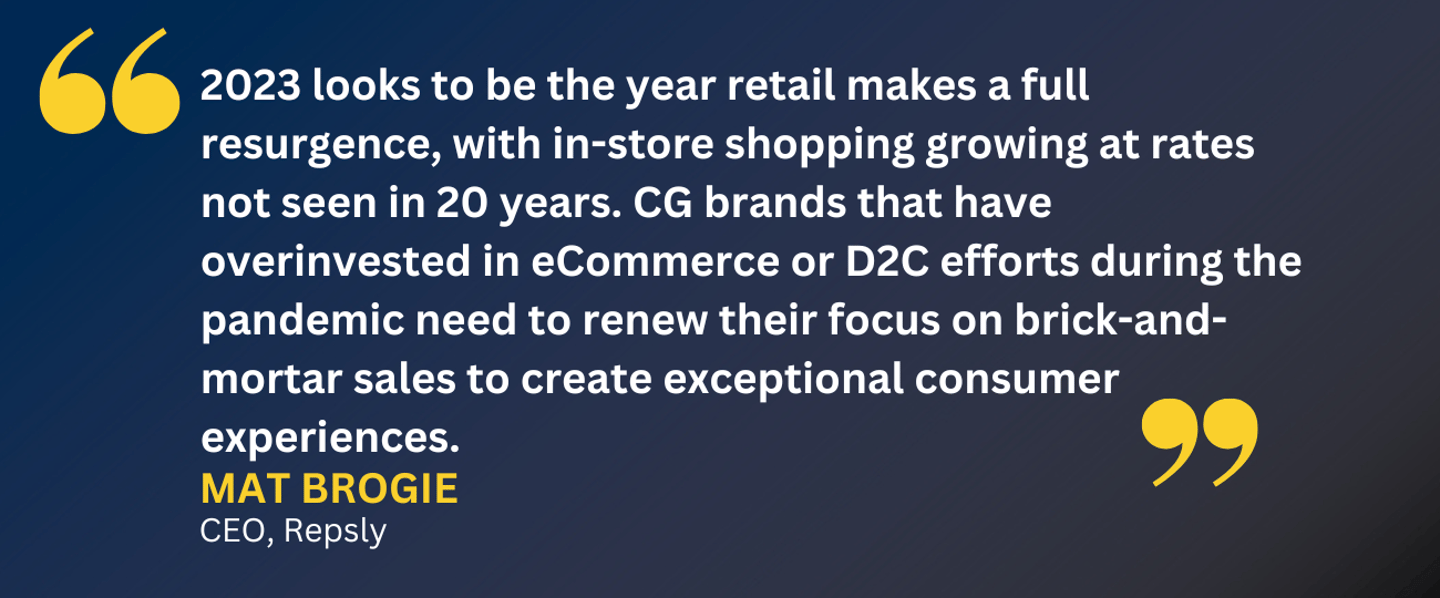Synthesizing Retail Execution Channels to Deliver Seamless Consumer Experiences
Retail execution is a complex machine with many moving parts that include needs from field reps, promotion and pricing expertise, and consumer goods companies' investments into data-driven, brand-building initiatives. In an increasingly omnichannel market — where consumer expectations are sky-high — retail execution teams are charged with the not-so-simple task of synergizing these channels, tracking trends, and striking the right balance between people and technology investments.
In this Q&A, Mat Brogie, CEO of Repsly, outlines some of the biggest challenges facing CGs within retail execution today, and what companies must do to move away from the legacy practices holding them back. Brogie also offers words of advice on how CGs can build a more robust, fit-for-purpose REX strategy that seamlessly executes the consumer experience.
CGT: What are some of the biggest challenges facing consumer goods companies right now within retail execution? How much are legacy practices and ways of thinking hampering success?
Mat Brogie: According to almost all recent prediction pieces published by the big 3rd party research and advisory firms, 2023 looks to be the year retail makes a full resurgence, with in-store shopping growing at rates not seen in 20 years. CG brands that have overinvested in eCommerce or D2C efforts during the pandemic need to renew their focus on brick-and-mortar sales to create exceptional consumer experiences.
One of the biggest challenges they will face in doing so? Their plans to tackle retail rely too much on the people side of the execution plan, and not enough on technology and action-oriented use of their data. Our 2023 Retail Outlook study found that consumer goods marketing and sales executives who oversee the retail channel are going into the new year with plans to grow their teams rather than investing in technology, in spite of the fact that their most significant challenge is hiring and maintaining field teams. And in spite of the fact that brands that leverage technology to quickly adapt to changing needs and demands outperform their peers by 2.8 times.
So why the disconnect on the plan of attack? We believe it’s because CGs have struggled to fully realize the power of smart retail technology to support their goals. They’re relying on old thinking patterns and ways of operating, assuming that hiring more people is the way to progress.
A brand’s field teams are a powerful asset, there’s no question about that — but when those teams lack the tools and actionable data they need to drive smart decisions, and ultimately, drive growth, it's like sending them into the wilderness with no compass. We see a lot of legacy practices still in play, where teams focus too much on gathering a greater volume of data instead of surfacing valuable data trends that allow leaders to take action.
CGT: An effective REX framework requires clear communication between a number of different teams. How can technology help to bring all these teams together with one cohesive, coordinated view of the in-store experience, and facilitate the flow of information among these different groups?
Brogie: Store managers often work in an “analog world,” walking the floor, addressing problems in a hands-on way, and managing people "face to face." This applies not only to their own employees but suppliers as well.
We see there are several ways that this modus operandi can be made more efficient and effective through technology:
- Coordinated Schedules: A supplier sends a product to a store, the supplier schedules merchandisers to pack it out, and the store manager has access to (and even input to) the schedule.
- Field Team Issue Resolution: Field reps can create tickets for things like phantom stock - driving collaboration between supplier and store.
- Major Reset Communications: Stores planning major resets can communicate with supplier field teams to a) support the work, b) stay clear of the work, and c) adjust product orders to support the new layout.
All of this is feasible and can be a reality today — but it takes real partnership and investment from both the retailer and supplier.
CGT: Where should CGs channel their efforts when it comes to building an effective REX framework?
Brogie: The ideal framework — or maybe we should say the intelligent REX journey — we endeavor to take with our customers is to work together to say, “What are your goals? What are you trying to achieve as a company, and as a team this year, in the retail channel? What key levers can you move, and what KPIs will help you control those levers?”
Then we move into analysis — let’s look at your data. That may be the activity data of your field team; how are things done today? It could be observational data like competitive presence, shelf health, points of presence; POS (point-of-sale) data from your retailers at the store level; and ideally, supply chain data, inventory, depletion, and shipment data.
The real-time analysis of these data inputs integrated and synthesized into intelligence can drive agility — which is the next phase of this framework. It can allow retail teams to see, react, and adapt quickly to a broad set of inputs, and communicate that plan up and down the organization when they are not yet hitting those key KPIs. This creates proactive retail channel teams, ones that can see problems coming, can weigh the impact of those problems, and proactively adjust before they impact sales goals and bottom lines.
Re-imagining your retail channel as a tied-in, omnichannel consumer experience is achievable. And your field teams — your superpowers on the streets — can ensure this experience matches your collective team’s visions and perfectly executes the consumer experience.






